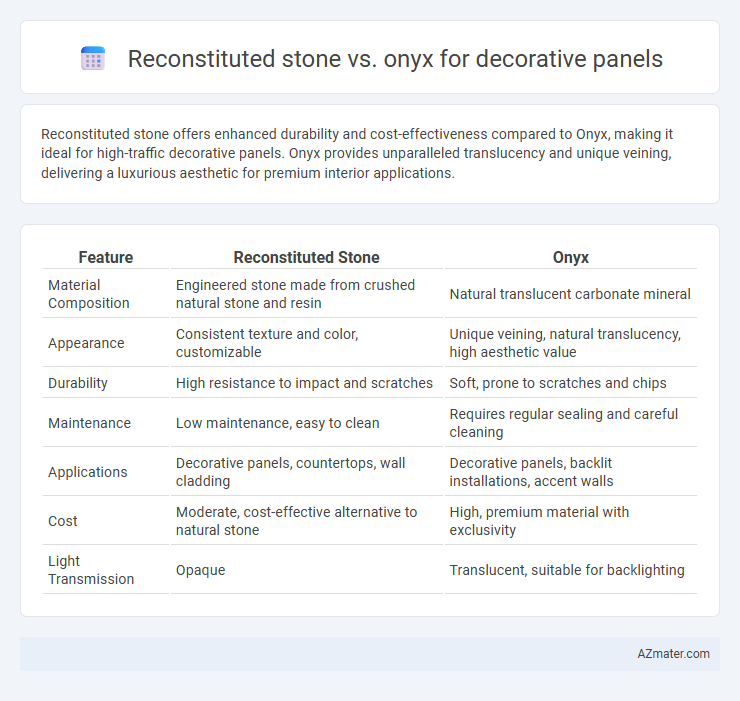Reconstituted stone offers enhanced durability and cost-effectiveness compared to Onyx, making it ideal for high-traffic decorative panels. Onyx provides unparalleled translucency and unique veining, delivering a luxurious aesthetic for premium interior applications.
Table of Comparison
| Feature | Reconstituted Stone | Onyx |
|---|---|---|
| Material Composition | Engineered stone made from crushed natural stone and resin | Natural translucent carbonate mineral |
| Appearance | Consistent texture and color, customizable | Unique veining, natural translucency, high aesthetic value |
| Durability | High resistance to impact and scratches | Soft, prone to scratches and chips |
| Maintenance | Low maintenance, easy to clean | Requires regular sealing and careful cleaning |
| Applications | Decorative panels, countertops, wall cladding | Decorative panels, backlit installations, accent walls |
| Cost | Moderate, cost-effective alternative to natural stone | High, premium material with exclusivity |
| Light Transmission | Opaque | Translucent, suitable for backlighting |
Introduction to Decorative Panels: Reconstituted Stone vs Onyx
Reconstituted stone offers a durable and cost-effective solution for decorative panels, composed of crushed natural stone mixed with resin to mimic the appearance of natural materials. Onyx, a natural stone known for its striking translucency and rich veining, provides a luxurious and unique aesthetic but comes with higher maintenance and expense. Selecting between reconstituted stone and onyx for decorative panels depends on factors like budget, desired visual effect, durability requirements, and installation environment.
Material Composition and Structure
Reconstituted stone is composed of natural stone fragments mixed with resin and pigments, providing uniformity, strength, and versatility in decorative panels. Onyx is a natural crystalline carbonate mineral with translucent properties, characterized by its layered structure and rich, varied veining, often used to create visually striking panels with enhanced depth. The engineered composition of reconstituted stone offers greater durability and customization options compared to the more fragile, naturally occurring onyx.
Aesthetic Appeal and Design Versatility
Reconstituted stone offers a consistent appearance with customizable colors and patterns, making it ideal for achieving uniform decorative panels with a modern aesthetic. Onyx features natural translucency and unique veining, providing luxurious and striking visual interest that enhances ambient lighting effects in designs. Both materials support diverse applications, but onyx excels in statement pieces requiring intricate backlighting, while reconstituted stone suits large-scale installations demanding durability and design consistency.
Durability and Longevity Comparison
Reconstituted stone for decorative panels offers enhanced durability due to its engineered composition, which resists chipping, cracking, and staining better than natural onyx. Onyx, while prized for its unique translucency and aesthetic appeal, is softer and more susceptible to scratches and chemical damage, reducing its longevity in high-traffic or exposed environments. For applications demanding long-term resilience and minimal maintenance, reconstituted stone provides a more robust and enduring solution compared to the delicate nature of onyx panels.
Installation Process and Ease
Reconstituted stone panels offer easier installation due to their uniform size, lighter weight, and compatibility with standard adhesives, making them ideal for large surface applications without heavy lifting equipment. Onyx panels, being natural stone, require careful handling, precise cutting, and tailored backing to prevent cracking, often necessitating professional installation and specialized support structures. The installation process for reconstituted stone is generally faster and less labor-intensive, providing a cost-effective solution for decorative panels where ease of application is a priority.
Maintenance and Cleaning Requirements
Reconstituted stone offers greater durability and resistance to stains, making it easier to maintain with simple soap and water cleaning, while onyx requires more delicate care to prevent etching and discoloration from acidic or abrasive cleaners. Onyx panels benefit from regular sealing to protect their surface and maintain their translucent beauty, whereas reconstituted stone generally needs less frequent sealing due to its engineered composition. Choosing reconstituted stone reduces long-term maintenance effort and cost, especially in high-traffic decorative panel applications.
Cost Analysis: Reconstituted Stone vs Onyx
Reconstituted stone offers a cost-effective alternative to natural onyx, with prices typically ranging from $40 to $80 per square foot compared to onyx's premium cost of $100 to $250 per square foot. Manufacturing reconstituted stone from natural stone aggregates and resin reduces material waste and lowers installation expenses due to its uniform consistency and easier customization. Onyx, prized for its unique translucency and natural veining, demands higher maintenance and installation costs, impacting overall project budgets significantly.
Environmental Impact and Sustainability
Reconstituted stone panels offer a sustainable alternative to natural onyx by utilizing crushed stone and resin, significantly reducing quarrying and waste generation. Onyx extraction involves intensive mining processes that deplete non-renewable resources and result in higher carbon footprints. Choosing reconstituted stone supports eco-friendly practices through recycled materials and lower energy consumption, aligning with green building standards.
Common Applications in Interior Design
Reconstituted stone is widely used for decorative panels in high-traffic commercial interiors due to its durability and consistent appearance, making it ideal for lobbies, conference rooms, and retail spaces. Onyx, valued for its translucent quality and unique veining, is commonly applied in luxury residential settings, backlit wall panels, and feature walls to create dramatic lighting effects. Both materials enhance interior aesthetics, with reconstituted stone offering versatility in texture and color, while onyx provides an exclusive, natural elegance.
Which Material is Right for Your Decorative Panel?
Reconstituted stone offers durability, uniformity, and cost-effectiveness ideal for decorative panels requiring consistent texture and color. Onyx provides a unique, translucent aesthetic and natural veining, making it perfect for luxurious, statement pieces but demands careful maintenance due to its softness. Choose reconstituted stone for budget-friendly, resilient panels, while onyx suits projects prioritizing visual impact and elegance.

Infographic: Reconstituted stone vs Onyx for Decorative panel
 azmater.com
azmater.com